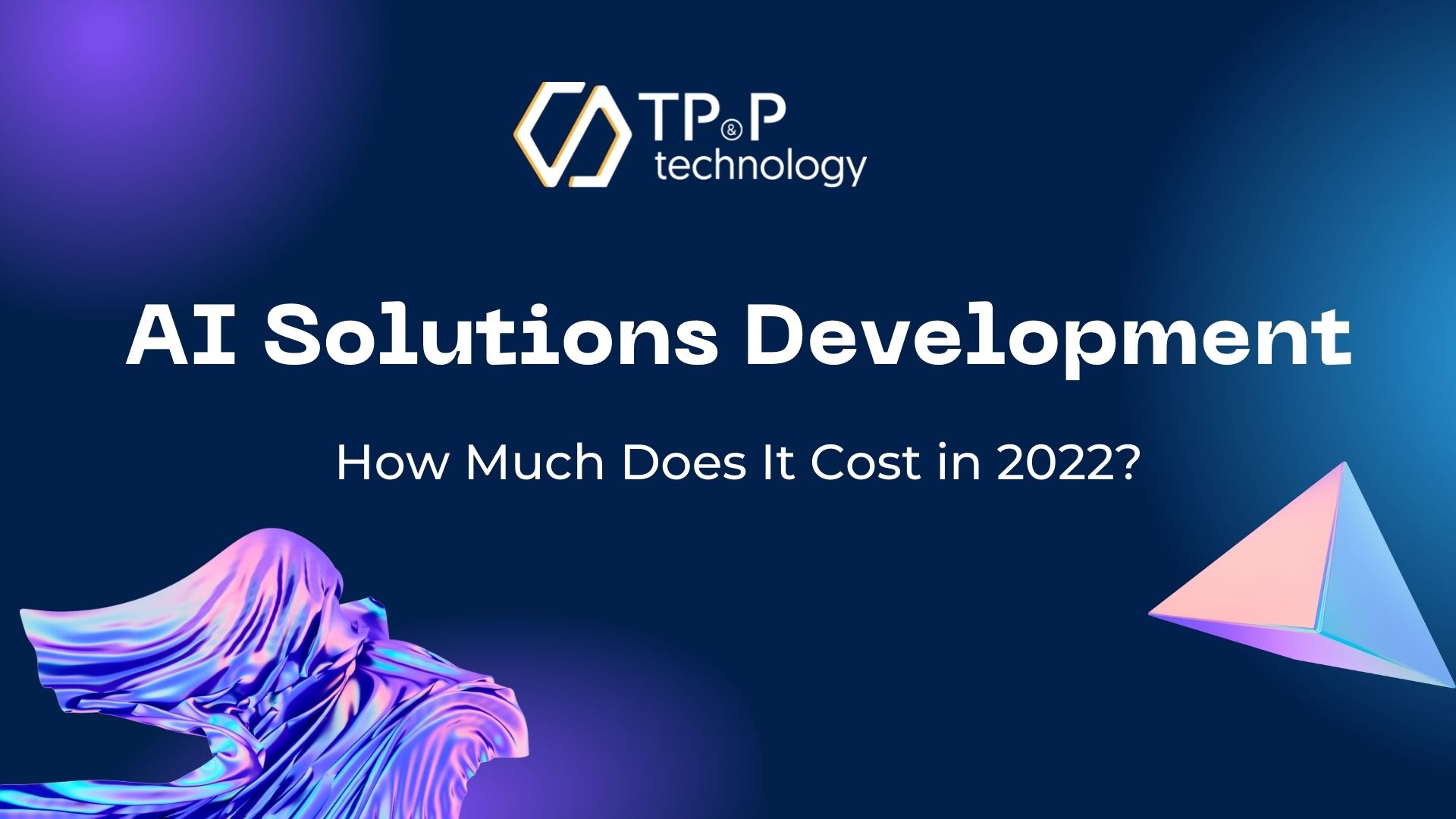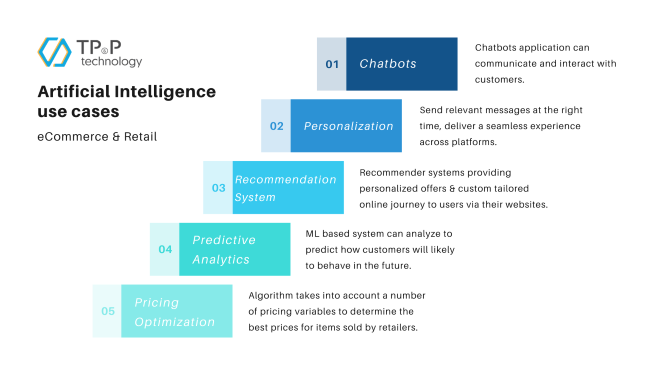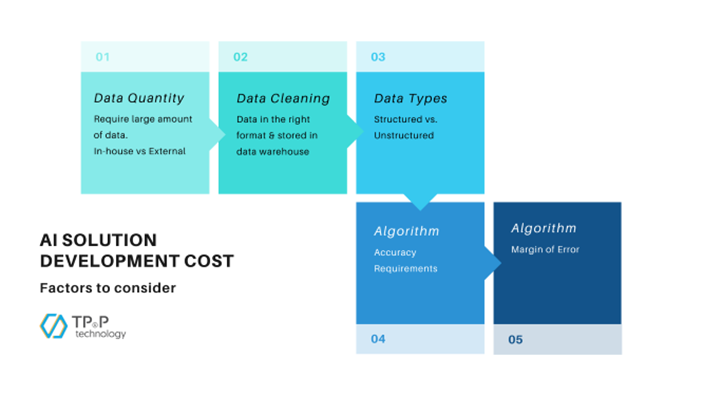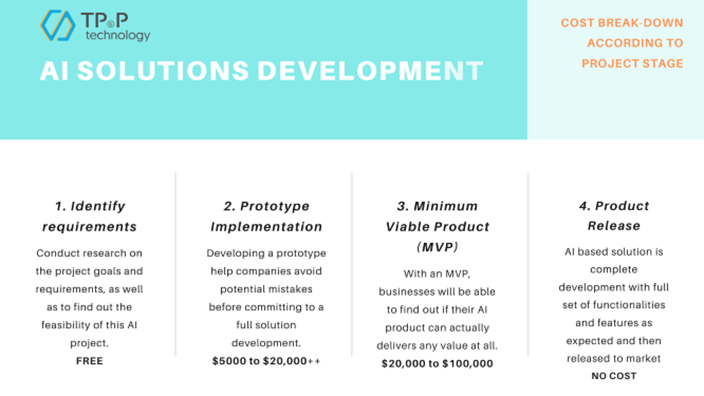
How Much Does Artificial Intelligence (AI) Solutions Development Cost In 2021-2022?
Artificial Intelligence (AI) and Machine Learning (ML) are among the most buzzed words in the IT industry in recent years, with a plethora of AI-based solutions that transform business processes in various industries, offering enhanced customer experience while bringing in more revenue at the same time.
Thanks to the numerous benefits that those AI-based solutions already deliver, many companies are now looking to invest in building their own AI-based solutions for their business process optimizations and also to gain a competitive edge in an increasingly competitive market.
However, before diving into the details of AI implementation cost, business organizations need to take a good look at the big picture, specifically the opportunity cost of AI implementation both in the short-term and long term.
In particular, how AI can benefit your businesses by helping a capture a larger market share keeping up with competitors through optimized business processes boosting employee productivity, and transforming customers' experience in a highly personalized way.
By skipping AI implementation, which is costly, your business might be able to cut down on the development costs but the long-term consequence could be much more expensive by losing market share to competitors.
In this article, we take a look at a number of key factors affecting the cost of AI implementation.
BENEFITS OF AI-BASED SOLUTIONS SOFTWARE
As mentioned in previous blog posts, AI and ML technologies surely have a lot to offer with many promising AI use cases for retail and other businesses across industries.
By automating menial and repetitive tasks as well as providing actionable insights to support better business decision makings, many AI-based solutions have become pervasive in the daily operations of many businesses. 
For example, E-commerce companies can leverage Machine Learning algorithms to provide personalized suggestions to their customers based on their past behaviors. In many cases, AI-powered chatbots prove to be very effective in substituting for human-providing customer experience.
Moreover, AI technologies also help businesses in gaining a highly competitive edge by making predictive analytics allowing businesses to forecast, for instance, inventory level and machinery maintenance, together with many other various use cases.
The fundamentals of IT Project Estimating
Before diving into AI cost, let’s have a quick reminder of IT project estimation fundamentals since AI project costs are an adaptation and evolution from that.
6 key aspects that influence one project estimation: time, cost, scope, quality, benefits, and risks. In the traditional Waterfall model, the estimation will occur in the planning phase after project initiation, while in Agile, the estimation occurs during the sprint retrospective.
In recent decades, despite IT projects still running late, serious and big setbacks are far less common. One of several reasons behind this is the widespread existence of more flexible development processes and shorter project cycles. Another reason is many adopt project quality indicators and continuously improve. The debate about IT processes and project management methods remains intense. However, IT projects' quotations will remain widely the same information from most suppliers. This will include a similar analysis of how the overall work is broken down into phases or activities.
This is quite similar to AI projects. The AI project's cost estimation now is like IT projects were years ago: inconsistent and often unreliable. A big reason is the difference in the AI development process and the perception of what AI product quality means. Therefore, AI project estimations are often driven by personal experience or project constraints more than objective considerations.
Creating and maintaining consistency in the way AI is constructed will provide a more objective basis for evaluating future AI projects. This will also enable you to improve and optimize your AI work while maintaining your supplier discussion position.
FACTORS AFFECTING AI SOLUTION DEVELOPMENT COST
The process of developing an AI-based solution has several specific factors which determine the final overall development cost.
A - Data Issues
A reliable AI system depends not only on the coding skills of the development team but also on the quality of data for the training algorithm model, which plays a critical role in the project's overall success.
This is because, first of all, a large amount of data is required to reasonably detect the hidden patterns that may exist between input data and output features. If businesses do not have enough data required, it’s possible to acquire data from external services or perform collecting more data which might be time-consuming.

The other solution is to employ data augmentation to increase the sample size artificially. All in all, this will lead to higher development costs.
Another requirement is that data must be cleaned and in the right format stored in the data warehouse. If this is not the case, then some preparation activities will be needed to clean data which could increase the development cost.
It’s also worth mentioning that it is easier working with structured data, and as a result cheaper. Hence, before starting their AI project, businesses need to perform a review of their in-house database to assess its quality and quantity and account for any future data preparation costs that may arise. In many cases, companies also need to account for working with missing data, dealing with errors, outliers, and so on.
In reality, many companies usually captured and manage a vast amount of unstructured data (e.g. audio, video, communication such as chats, social media posts, etc.) and would require more complex and advanced Machine Learning Algorithms to make use of this kind of data. This sort of project usually costs more to develop.
B - Algorithm’s Performance: Accuracy & Margin of Error
The algorithm’s level of performance is also another critical factor that affects the overall AI development cost, a high-quality and accurate algorithm requires extra fine-tuning which will come at additional expenses. Specifically, the performance level would vary according to the business's unique requirements and the acceptable margin of errors.
For example, an AI-powered healthcare solution for diagnosis might require a near-perfect accuracy level of analysis which is above 99%. On the other hand, for a manufacturing company, a machinery maintenance forecast system does not have to be at 99% accuracy, there’s a wider margin of error accepted.
Most (if not all) AI-based solutions require data and use data for the learning process of the algorithm. Thus, the quicker and more accurate the machine can learn, the better the solution.
AI DEVELOPMENT COST BREAK-DOWN ACCORDING TO PROJECT STAGE
Generally speaking, a typical AI project would be developed in phases instead of doing everything at once. The overall Artificial Intelligence (AI) solutions development cost depends on many factors including the size and scope of the project, hence, having a general idea of the project phases could be very useful in helping you to make an estimate of the overall development costs.
Following is the development roadmap adopted by TP&P Technology when developing AI/ML-based system.
1. Identify requirements
The objective of this initial stage is to conduct research on the project goals and requirements as well as to find out the feasibility of this AI project.
At this stage, it’s important for both customer companies and the technology partner to determine whether AI and ML technologies are really required and appropriate for this project. This starts with conducting research on customers’ operation processes, data, and business metrics as well as finding out exactly how companies can address their key business problems using AI.
If an AI solution is feasible and applicable, then the next step is for the development team to identify the suitable technologies stacks and timeline, budget as well as metrics for success measurements and improvement.
Once it’s clear that AI technology is suitable for the project, then it’s time to move forward with the project by estimating the scope of work needed for further development. Yet, before committing to further development, it’s critical to have all the required data, and metrics readily available to ensure the project can be moved along.
Many software companies usually help their client by doing this for free.
2. Prototype Implementation and Evaluation Phase
Before committing to a full-scale AI solution, many companies usually consider prototype or MVP development in order to examine the feasibility and validate if their idea could be bought to life at all. The purpose of developing a prototype is to help companies make decisions about their product development and avoid potential mistakes before committing to full solution development. A prototype is a working model that covers various aspects of the product which allows the development team to test product design, usability, and functionality.
Again, prototype development costs would vary according to specific business requirements as well as project scope, technologies, and tools required for the development. Typically, a prototype may cost as low as $5000 to $20,000 and more.
3. Minimum Viable Product (MVP)
Based on the findings of the prototype, an MVP is then developed and delivered to the market as a minimum version of the final product. This means that the MVP has to be simple and well-packed without errors or bugs.
It can be said that building an MVP is an absolute must for businesses. This is because, without an MVP, businesses wouldn’t be able to find out if there are any potential problems with their machine learning solution and also what the exact root cause of those problems is. Any effort into fixing those problems might result in a waste of time and money. For example, the issue could be related to data quality, so any effort put into deployment could go to waste and vice versa.
With an MVP, businesses will be able to find out if their AI product can actually deliver any value at all, and once it does, then companies can start to have a full-scale AI solution with additional features ready to be developed.
An MVP model cost may vary between $20,000 and up to $100,000, depending on the project size and complexity.
4. Product Release
Finally, the AI-based solution is complete development with a full set of functionalities and features as expected and then released to the market. The cost of this stage is usually already incorporated into the budget before, so there should be no extra cost incurred.
SO, HOW MUCH DOES IT COST?
A few years ago, only tech powerhouses such as Google, Microsoft, and Amazon could afford to have their AI solutions developed for businesses, now many companies can indeed manage to leverage the power of Machine Learning technology at a very reasonable cost.
Nowadays, with the increasing availability of various tools, and frameworks for developing AI-based solutions, AI technologies are gradually becoming more easily accessible to businesses. Generally speaking, companies can either hire and set up their own in-house AI team for long-term projects or outsource their AI project to an external vendor. A few key factors to consider:
i) AI engineer's salary
According to Indeed.com, the average Machine Learning engineer salary in the USA is about $142,859 per annum, with other AI job titles all making upward of $100,000 per year, including Data scientists earning on average $126,927 per annum and Algorithm engineers making $109,313. It’s very clear from this report that the cost of hiring AI/ML engineers is higher compared to other software developers. Additionally, these figures indicate a clear trend of demand for Machine Learning Engineers is really high these days.
ii) Outsourcing
In general, it's difficult to figure out exactly how much it would cost to develop an AI-based solution.
The cost varies case by case, which ultimately depends on the project size, scope, and complexity, as well as specific business requirements along with other factors mentioned above.
iii) Hire a dedicated AI Development Team
A typical AI development project would require a multi-disciplinary team consisting of artificial intelligence (AI) / Machine Learning (ML) engineers, data scientists, and web developers, as well as other IT professionals such as designers, project managers, etc. Thus, the salary and total cost of hiring local IT talents and training them could prove to be extremely high due to the high market demand as mentioned before. This creates many obstacles for the companies in the developed nations to establish their own in-house AI infrastructure.
As a result, many companies turn to outsourcing services by hiring a dedicated team for their AI development project. By employing outsourcing services, companies can save time and money while still maintaining product quality as required. TP&P Technology offers highly qualified and skilled Vietnam AI engineers and Machine Learning consulting services for your project's requirements at highly competitive costs.
Contact us today to talk to our dedicated specialists about your AI requirements.



